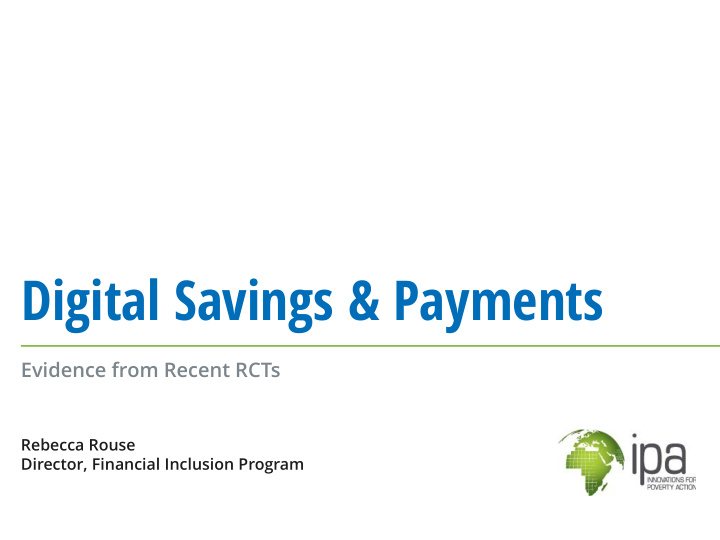



Digital Savings & Payments Evidence from Recent RCTs Rebecca Rouse Director, Financial Inclusion Program
Innovations for Poverty Action IPA: An international non- profit research & policy organization founded in 2002 by Dean Karlan, a Professor of Economics at Yale Our Vision: Our Mission: More Evidence, Less Poverty To discover and promote effective solutions to global poverty problems
Financial Inclusion Program 130+ projects 3 Initiatives: Financial Services, Financial Capability, US Finance Competitive research fund • Next Call for Expressions of Interest in Fall 2016
The Promise of Digital Payments Why do we believe that digital payments should be good for development? • Security and reliability • Speed of payments • Transparency and fraud reduction • Reduced transaction costs • Point of entry for broader financial inclusion
What does the research tell us? Two studies provide new evidence on the impact of digital payments on these outcomes 1. Building State Capacity: Evidence from Biometric Smartcards in India • Corruption, transaction costs 2. Mobile-izing Savings with Automatic Contributions: Experimental Evidence on Dynamic Inconsistency and the Default Effect in Afghanistan • Leveraging digital payments for savings outcomes
1. Digitizing Payments: AP Smartcards Karthik Muralidharan, Paul Niehaus, & Sandip Sukhtankar Can Smartcards (biometric authentication + electronic transfers) improve the functioning of government welfare schemes?
Welfare Programs: Can Be Inefficient, Leaky • Welfare programs can suffer from corruption and inefficiency • NREGS & SSP in Andra Pradhesh • Payments often late • Payments time-consuming to collect • High leakage rates (over-reporting, ghosts, under- payment)
Potential Solution: Smartcards + CSP Payments • Intended impact: • Reduce financial leakages • Reduce transaction costs • Reduce time spent accessing payments • Potential negative side effects: • Limitation of participation (if beneficiaries do not register, lose their cards, face technical challenges) • Corruption may be displaced to other areas
Payments Process Before Digitization Before Digitization Paper muster rolls maintained by Gram Panchayat and sent to Mandal computer center Digitized muster roll data sent to state financial system Money transferred electronically from State to District to Mandal Paper money delivered to GP (typically via post office) and then to workers
Payments Process After Digitization Before Digitization Paper muster rolls maintained by Gram Panchayat and sent to Mandal computer center Digitized muster roll data sent to state financial system Money transferred electronically from State to Bank to Technology Service Provider to Customer Service Provider Customer Service Provider delivers cash and receipts to authenticated recipients
Results • Reduced NREGS payment time by 22 minutes (20%) • Reduced lag between NREGS assignment and payment by 5.8-10 days (17-29%) • Increased NREGS payments by Rs. 35 (24%) BUT government outlays didn’t change, suggesting reduction in leakages • Beneficiaries were satisfied, but many reported fear of losing their Smartcards or problems with authentication
2. Digitizing Savings: Mobile 401K Plan Josh Blumenstock, Tarek Ghani, & Michael Callen Can default enrollment of employees into an automatic savings program increase balances over the medium term? How does providing matching incentives compare?
Saving is Important but Difficult • Enable people to smooth consumption, make investments, cope with emergencies • But basic human tendencies can get in the way (e.g. self-control issues, procrastination, etc.) • In Afghanistan, additional issues: • Distrust of formal banks • Underdeveloped banking sector • Only 4% of people in Afghanistan save formally
Potential Solution: M-Pasandaz Mobile Savings • Mobile phone usage widespread: fast recent growth, high overall penetration • Telecom Roshan disburses salary over M-Paisa platform • M-Pasandaz: savings account that uses the M-Paisa platform • Basic savings account functionality • Automatic payroll deduction option • Allows employer matching incentives
Which Method is More Effective? Defaults or Matching Incentives? • Default enrollment: leverage behavioral insights • Employees enrolled by default to automatically save 5% of salary every month • Can change automatic deduction at any time (to anything up to 10%; takes 2-3 minutes to change) • Matching incentives: pay people to improve habits • Company offered 25% or 50% match to employees if they enrolled in automatic contributions • Incentives provided as lump sum if no withdrawals made for first 6 months
Results • Impact of default enrollment: • Increased likelihood of making automatic contributions by 40 percentage points • Increased average savings by about $40 over 6 months • Impact of matching incentives • 25% match increased likelihood of automatic contributions by 25 percentage points • 50% match increased likelihood of automatic contributions by 47 percentage points
Do Digital Payments have the Intended Impacts? Yes! • Security and reliability: YES: PROCESSING TIMES REDUCED • Speed of payments: YES: CUSTOMER TRANSACTION TIMES REDUCED • Point of entry for broader financial inclusion: YES: SAVINGS SCHEMES LEVERAGING DIGITAL PAYMENTS PRODUCE MORE SAVINGS
Scaling Up Financial Inclusion Linked to Digital Payments • Government payments, including social payments (G2P) • Private employers, via salary payments (B2P) • International and domestic remittances (P2P)
Digitization Alone is Not Enough • Functioning payments ecosystems • Lessons from behavioral economics/attention to User Experience • Consumer protection issues
Thank you! www.poverty-action.org/financialinclusion rrouse@poverty-action.org
Recommend
More recommend